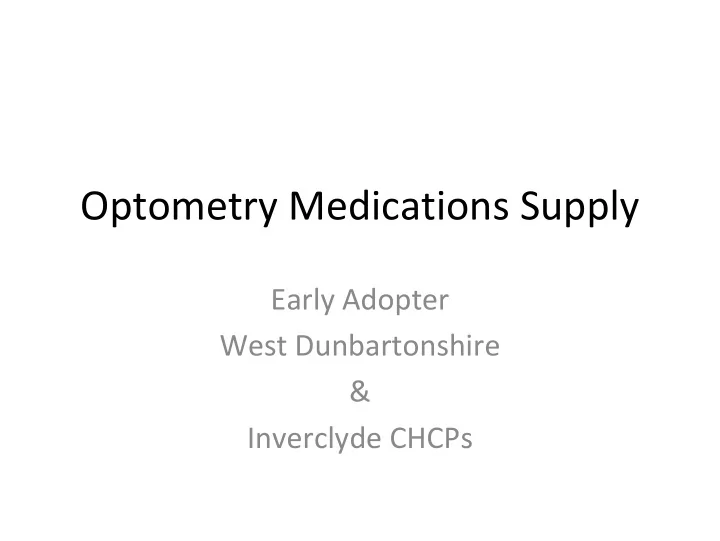

Optometry Medications Supply Early Adopter West Dunbartonshire & Inverclyde CHCPs
The Concept • Optometrists will supply from a range of medications as deemed appropriate to the patient’s presenting signs and symptoms. • Optometrists are now the ‘First Port of Call’ for all eye conditions in the community • Can we devise a method to allow Optometrists to supply these medications, to NHS standards, direct to patients at the point of diagnosis?
The Hurdles • The Cost difference – Optometry cannot source eye preparations at the NHS Tariff price. • Easy access to the preparations by Optometry Practices • Correct labelling of the product. • Understanding the Cost Implications of creating hundreds of new prescribers.
The Key Elements • Agreement from other professional groups that this should improve the service. • Medications and Healthcare products Regulatory Authority(MHRA) advise that Optometrists can label eye products. • Agreement that Optometry practices can source the listed products at the agreed tariff price. • Agreed GGC forms to record the supply & claim payments. • Pilot the roll out to assess the service and cost implications.
The Solutions • Optometrists buy from current supplier and keep stock appropriate to their own needs • Optometrists label product within their own practice (legal requirement). • Patients sign a form indicating they have received the stated preparations • GGC process claims and PSD pay the submissions within the monthly schedule. • Prescribing Support & PCS monitor activity and costs
The Medication List • Hypromellose 0.3% • Carbomer gel 980 • Lacrilube Eye Ointment • Chloramphenicol 0.5% Eye drops • Chloramphenicol 1% Eye ointment • Fucidic acid 1% viscous Eye drops • Sodium Cromoglicate 2% Eye drops • Olopatidine 1mg/ml (requires PGD)
Additional PGD • The Patient Group Direction (PGD) allows Optometrists to supply a Prescription Only Medicine under defined circumstances. • Pharmacy and Optometry combine to create a PGD for Olopatadine 1mg/ml • Approval gained. • Optometrists decide whether to sign up to be able to supply Olopatadine according to the terms of the PGD.
Labelling • The name of the patient • The name of the medicine • Directions for use • BNF precautions relating to the use of the medicine • The words “Keep out of the reach and sight of children” • The words “For external use only” • Date of dispensing • Name and address of the optometric practice
Label Example Wilkie & Rider, 3 College Way, Dumbarton Keep out of the reach and sight of children FOR EXTERNAL USE ONLY 5ml Opatanol 0.1% EYE DROPS Put One drop(s) into the _____ eye(s) TWICE daily. Discard contents FOUR WEEKS after opening. Patient:______________Date:_______
Glasgow Formulary • DRY EYE • Hypromellose 0.3% is considered the first line treatment option for patients complaining of ‘dry eyes’ or tear deficiency. • CARBOMER 980 (CLINITAS GEL) (EYE DROPS) • carbomer 980 (VISCOTEARS) • carbomer 980 (GELTEARS) • LIQUID PARAFFIN (LACRI ‐ LUBE) (Eye ointme
Glasgow Formulary Anti Infective • CHLORAMPHENICOL Prescribing Notes: • Available as 0.5% drops (which must be stored in a fridge), and 1% eye ointment. • FUSIDIC ACID Prescribing Notes: Available as modified ‐ release 1% viscous eye drops. Fusidic acid should only be used for staphylococcal infections such as blepharitis, not bacterial conjunctivitis.
Glasgow Formulary ‐ Anti Inflammatory • SODIUM CROMOGLICATE (2%) (EYE DROPS) Prescribing Notes: The 2% eye drops are the first ‐ line anti ‐ inflammatory preparation. • OLOPATADINE (EYE DROPS) Restrictions: Restricted to second ‐ line when sodium cromoglicate is ineffective or not tolerated. • www.ggcprescribing.org.uk
The College of Optometrists Guidelines • Tear deficiency • Blepharitis • Conjunctivitis ‐ acute allergic • Conjunctivitis ‐ bacterial www.college ‐ optometrists.org Members log in – clinical management guidelines
Payment Verification • Separate record card per NHS investigation – primary or supplementary. • Medication supplied written on card. • Patient Medication Supply form completed, signed and retained in monthly batch. • Summary form completed and sent every month, duplicate retained.
Governance • The GOS aspect of the Early Adopter/Pilot is no different from any other examination. Extra Information required • Medication – Type, batch no and expiry date. • Patient Instructions – Frequency and duration of treatment. • Follow up – further appointment, contact details, and reporting procedure. • Copy of GP Communication form .
Governance • Monitoring of Rx Supply will be carried out by Margaret Ryan, (Lead of Prescribing Governance for NHSGG&C) and her team. They will receive regular reports on the supply activity from PCS/PSD
Questions
Recommend
More recommend